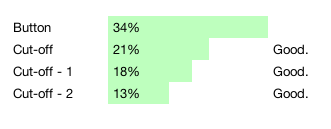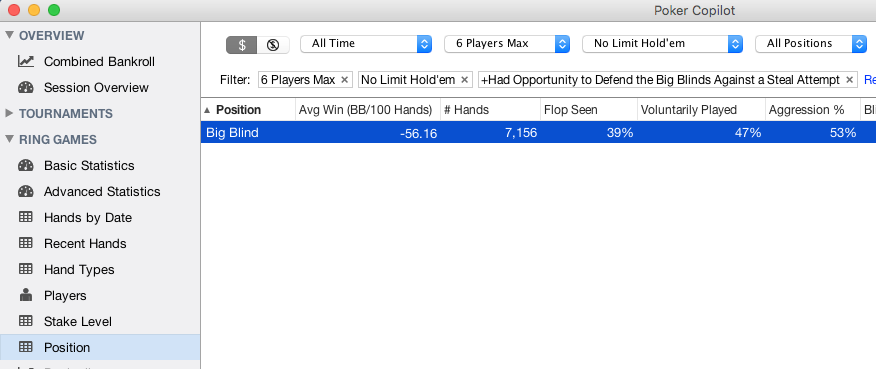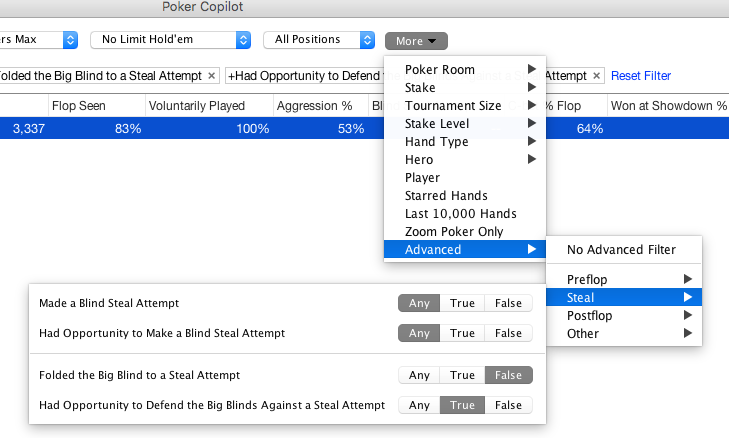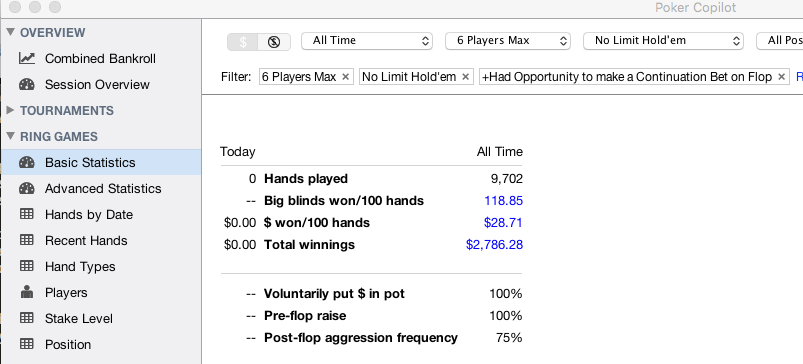8 Steps to Improve Your Poker Game with Poker Copilot
Here’s a guide to analysing your hand history with Poker Copilot. Make sure you have plenty of hands in your Poker Copilot database first, say 10,000 hands; there’s no point making changes to your game based on just a few hundred hands.
Choose first if you are focused on your cash game skills, or your tournament skills, your Hold’em or Omaha game, and your preferred table size. All the instructions here assume you are analysing 6-max No Limit Hold’em cash games.
1. Set the Filters
In Poker Copilot’s filter, set table size to 6 Players Max, and set game type to No Limit Hold’em. If you believe your playing style has changed a lot in recent months, consider setting the date to 6 Months.

2. Check Your Preflop Aggression
Do you have good preflop aggression? New poker players are scared of raising. They tend to call, call, call, which is an easy way to lose money.
If your hand is worth playing, then you should often raise. If it is not worth playing, you should fold. Beware the temptation to call.
In Poker Copilot, find the Leak Detectors at the bottom of the left-hand side menu. Select Preflop Aggression, then click on Start for Ring Games. Within a second or so, you’ll see a chart like this:

The bit we’re interested in is this:

The number you see next to each position is how often you made a preflop raise, based on all the hands you voluntarily put money in the pot. Where you see “Button 84%” it indicates that of all the hands in which you were on the dealer button and you put some money in the pot, you raised 84% of the time.
I recommend in each position you have a preflop aggression of at least 50%, except in the big blind. If you are not achieving this, you need to raise more preflop, fold more and call less.
3. Check Your Positional Awareness
Poker players soon learn to be more loose, the closer they are to the dealer button. When in the button you get more information before making a decision; conversely when you are under the gun you need to decide with less information than any other player.
In Poker Copilot’s Leak Detectors, select Positional Awareness. Click on Start for Ring Games.

The number you see next to each position is how often you put money in the pot from each position. The number should be consistently decreasing as you move away from the button. If this is not the case, you need to tighten up in early position (cut-off - 2) and loosen up in late position (the button).
4. Check Your Blind Stealing
Blind stealing, if done well, is highly profitable. When you are on the button, and every one has folded before you, you have a blind steal opportunity. You should be stealing roughly 50% of the time.
Many players are timid at blind stealing. If in doubt, try to steal. Do this often, and you’ll have an extremely high “big blinds won per 100 hands” for blind steal attempts. 20 times, 50 times, even 100 times your normal win rate is common.
In Poker Copilot’s Leak Detectors, select Blind Stealing. Click on Start for Ring Games.

Poker Copilot will give you a score of “good” for any blind steal attempt rate of 20% or higher. But be bold, and aim for 50%. It will pay off.
5. Check Your Blind Defending
Consider only the hands in which you are the big blind, and are facing a blind steal attempt. If you folded your big blind every time you were in this situation, you’d lose exactly one big blind per hand, which is a precise average of 100 big blinds/100 hands.
If you are defending against blind steal attempts judiciously, then you should have an average win in big blinds/100 hands much better than this.
Here’s how to check if this is the case.
- In Poker Copilot’s filter bar, select More -> Advanced -> Steal -> Had Opportunity to Defend the Big Blind Against a Steal Attempt -> true
- In Poker Copilot’s left hand menu, select Position
- The “by Position” table will show exactly one row. This is a summary of all your blind defence attempts.
- Find the Avg Win (BB/100 Hands) column.

Does this show a number less than –100? You are defending the blinds poorly. Most likely you are trying to defend hands not worth defending.
You can find the hands you tried to defend by selecting from the filter bar More -> Advanced -> Steal -> Folded the Big Blind to a Steal Attempt -> false

Now take another look at the Position table. Double click on the single row in the table to see a list of all hands in which you defend the blinds against a steal attempt. Click on the column header of the Winnings BB column. This will bring your big losses to the top. Now check the Down Cards column. If you see any trashy hands in here, these are the hands you need to fold in future.
6. Check How You Play Pocket Pairs
Remove all filters except 6 Players Max and No Limit Hold’em. (Tip: you can remove a specific filter by clicking on the small x symbol on the filter’s right-hand side.)
From the Leak Detectors select Pocket Pairs. Click on Start for Ring Games.

In the results, in the first column make sure AA through 88 all show a VPIP of at least 85%. Less than that means you are too timid with these powerful hands. AA, KK, QQ should all have a VPIP close to 100%.
In the second column, you want an extremely high ratio of PFR to VPIP. These are raising hands, not calling hands.
You should have a positive value for Big blinds won/100 hands for every single pocket pair. If there are exceptions, then you’ve got a big leak. Over the long run, you should not be losing money from any pocket pair.
7. Check How You Play Suited Connectors
Here you want to check that you are not overplaying suited connectors. It is too easy to misread these as powerful hands. Being connected only adds roughly 2% to your chances of winning, so don’t, for example, get too attached to T9 suited.
From the Leak Detectors select Suited Connectors. Click on Start for Ring Games.

For AK, you should see a high percentage of VPIP, PFR/VPIP, and Preflop raised. However the percentage should quickly drop for VPIP and Preflop Raised as you move down the list of suited connectors.
Check your Big blinds won/100 hands. AK is a premium hand, and you should have an extremely high number here. For other hands, look for any with a big loss. Consider folding these hands more often.
8. Check Your Continuation Bets
A continuation bet is when you continue your preflop aggression on the flop. You should be doing this the majority of the time. You want to make your opponents uncertain about their hands, even if they hit the flop. If you don’t have a good reason for checking on the flop after being the last to raise preflop, then you should be betting.
When an opponent calls your preflop raise and sees the flop, they are probably going to miss the flop roughly two-thirds of the time. Furthermore they probably think you've got a good hand. Your continuation bet gives the impression that your hand is good and you've hit the flop. It is an intimidating move and should be part of your poker toolkit.
To check your continuation bets in Poker Copilot, from the filter bar select More -> Advanced -> Postflop -> Had Opportunity to make a Continuation Bet on Flop -> true. Now select from the left-hand menu Basic Statistics.

Your postflop aggression should be high; 75% is reasonable and a good aim.
This is a short and well-rounded guide to analysing your poker game with Poker Copilot. Depending on your playing style, you can perform similar investigations into your check-raises, your 3-betting, and your squeeze bets. Just remember to keep your table sizes and poker variants separate when doing this, and you’ll get useful numbers that you can use to improve your poker game.